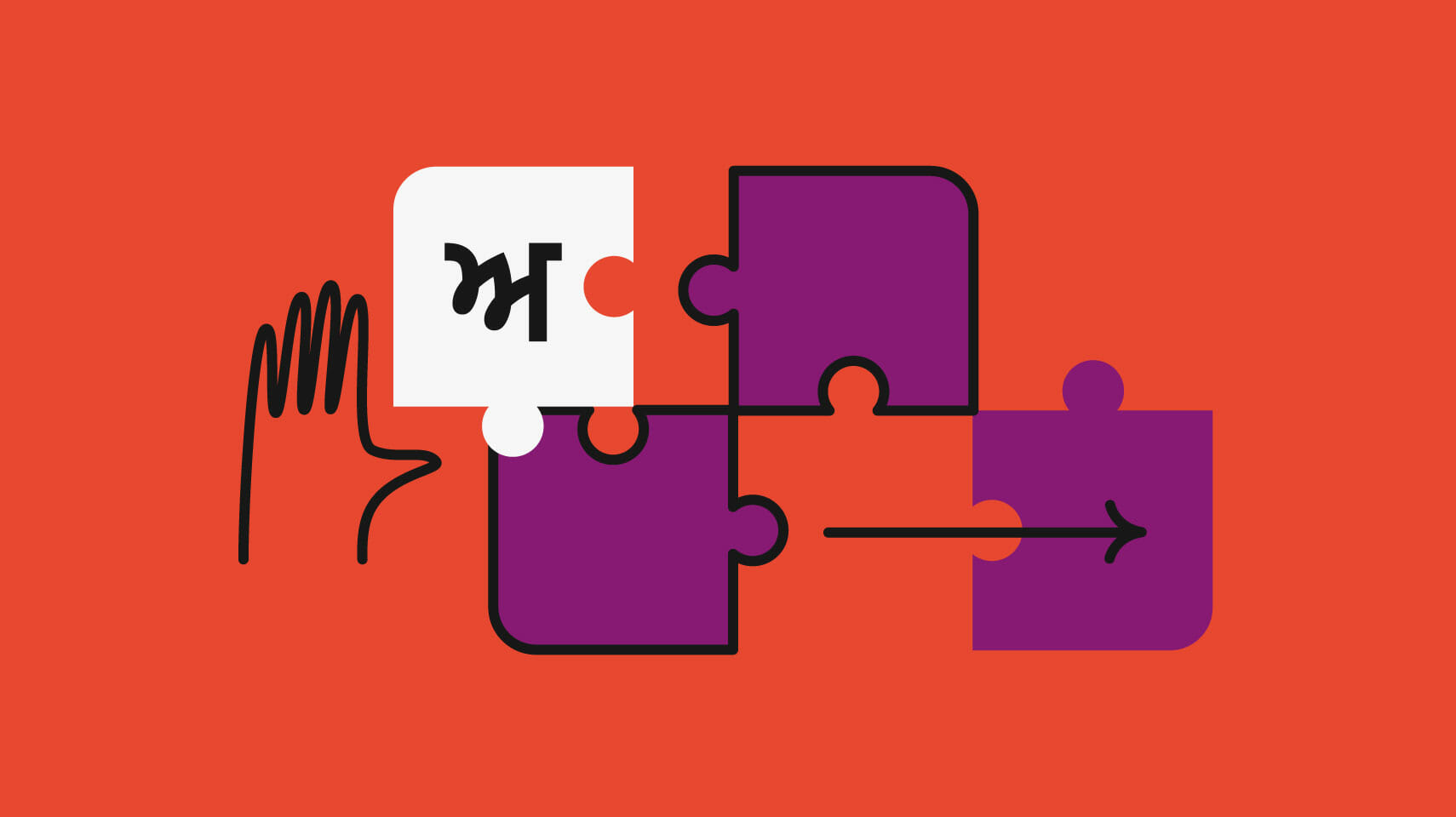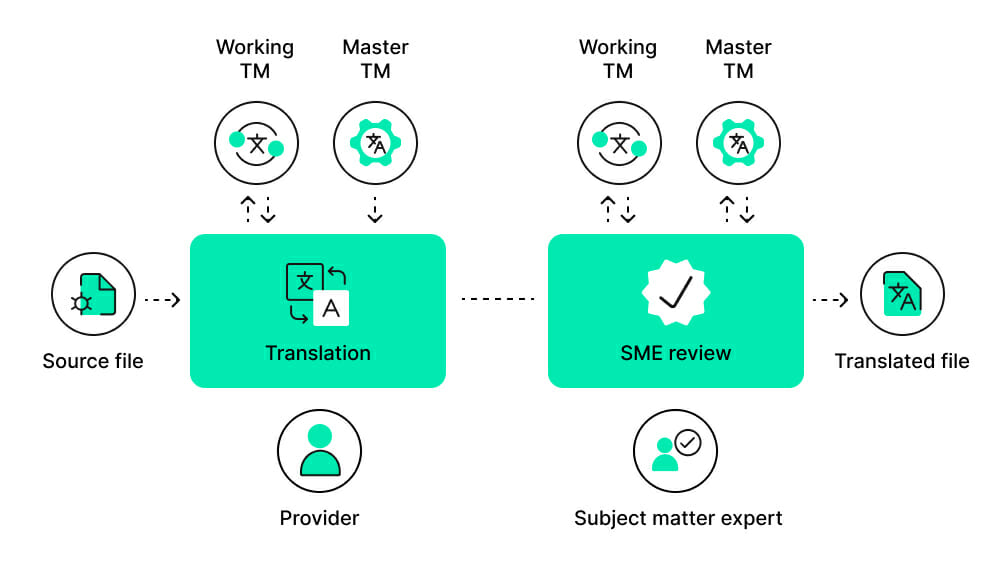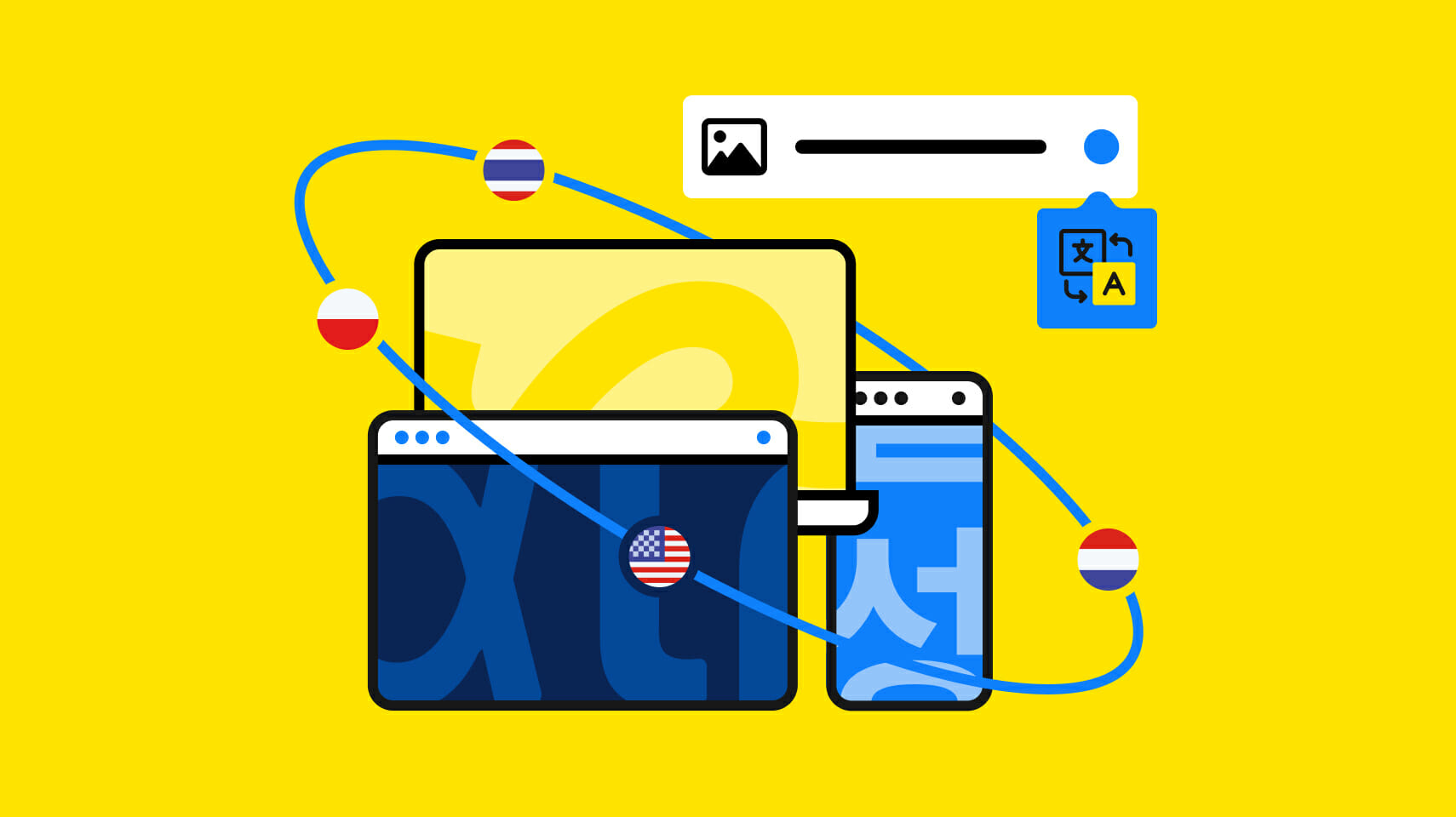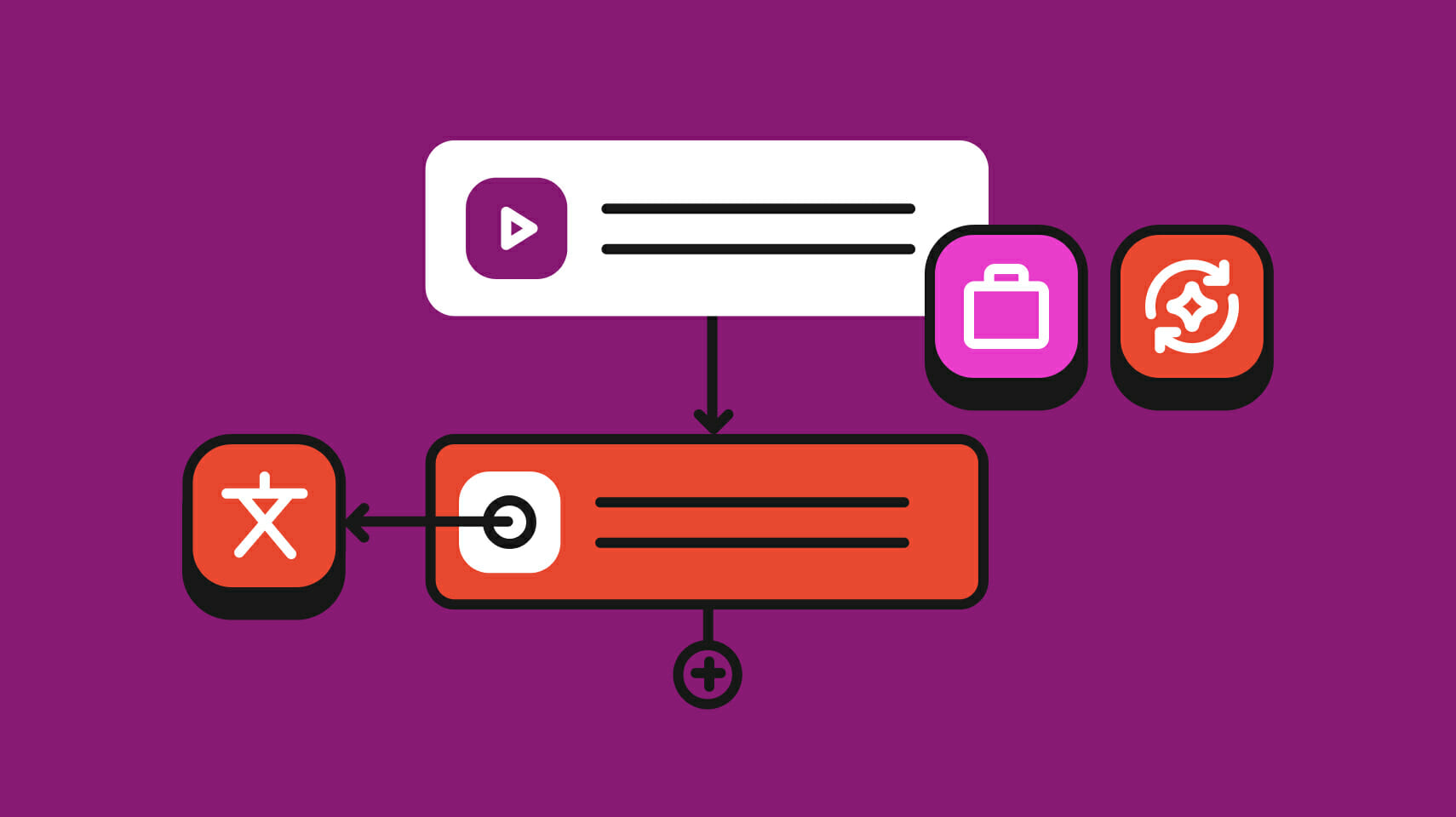Translation management
Translation Memory: What It Is, and How to Use It

The ever-growing need for translated content in the global marketplace exceeds the overall productivity of human translators. That is why translation technology has generated an increasing interest since the 1950s. Here are a few milestones:
- The 1954 Georgetown experiment in the US, which produced a machine able to translate a limited vocabulary range from Russian to English
- The advent of personal computers in the 80s and of computer-assisted translation (CAT) tools in the 90s
- The more recent progress of machine translation (MT) and the increasing popularity of machine translation engines like Google Translate or Amazon Translate
The invention of translation memory (TM), also referred to as translation memory software, is yet another milestone in the evolution of translation technology. Ever since scholars started exploring the concept in the 1970s, translation memory has become one of the pillars of CAT tools. Keep reading to learn how a translation memory works, what benefits it has, and how to best use it for streamlined translation.
What is a translation memory?
Translation memory is a database pairing segments of texts in a source language with their counterparts in a target language. These text segments are known as translation units and can be as long as a paragraph, sentence, phrase, or simply a string of words.
This means that a translator working with translation memory software does not have to start working on every new translation project from scratch. They can rely on their previous work or that of other translators when a company collaborates with different professionals. Translation project after translation project, they enrich the database with newly translated, reusable content.
Translation memory software has become such an integral part of translation projects that, according to a CSA Research study, a vast majority of translators who rely on modern CAT tools routinely use TMs. Only 12% of the surveyed translators never use them.
Translation memory vs term base: What’s the difference?
A glossary or term base is also a searchable database, but it works on a different level. While a TM is all about retrieving similar translation units of texts, a glossary is focused on specific terms and is best compared to a dictionary. A term base may specify the translation of a given word, its definition, and its usage rules.
A term base is advantageous for:
- Technical terms—translators can make sure they are using the correct translation across all languages
- Acronyms—a similar acronym may stand for something different from one industry to the next. A glossary gives the information they need to the translators, so there are no translation mishaps
- Product names—they are specific to your business and must be translated in a particular way, or sometimes should not be translated at all. There again, the glossary helps the translator make the right decision.
Translation memory vs machine translation: How do they differ?
Translation memory and machine translation have similar acronyms, which can be confusing enough, and they both provide translated texts. However, they originate from two very different sources.
While a translation memory is built over time by translators adding new content to the database, machine translation provides a text generated without any human input. It solely relies on routine automation.
With machine translation usually comes the dilemma of quantity vs quality. MT can process significant amounts of text quickly. However, because machines do not have the same feel for language as humans do, the quality of the output can sometimes be questionable. That is why post-editing by human translators is essential when using machine translation.
How does translation memory software work?
First things first, the translator submits content for translation by uploading a file in the CAT tool or translation management system (TMS). The translation platform thoroughly analyzes the source text and retrieves any matching translated content in the translation memory. The translator can now view both the source text pulled from the database and the suggested translation. Comparing them with the original source text, the translator can move on with one of the following actions: accept the proposed translation, make changes to it, or create an entirely new translation.
Perfect and fuzzy matches
Translation memory software has a rating system for defining the accuracy of translation matches. A perfect match, where the segment of text in the source file is identical to the text in the TM, is a 100% match. When only parts of the translation unit correspond to the content of the database, the match is called “fuzzy.” The higher the percentage of the fuzzy match, the more accurate the match is.
With a fuzzy match, the translator can decide to reuse the content of the TM but will have to make some changes to create an accurate translation. When there is no match, the translator needs to come up with a completely new translation that will be added to the TM, further building up the database for future projects.
In parallel to enriching a TM during the translation process, you can also create and build up a translation memory using alignments tools that are often part of translation tools. They allow you to take a source file and enter its content with its existing translation in your database. The alignment tool will segment the text in both the source and target language so they can be reused in the TM in future translations.
When should I use a translation memory?
Using a translation memory is great when you regularly need to translate content from one language to another, especially when there is a repetitive aspect to all or part of that content. In fact, it would take less time to list the areas where a TM would not add value than the other way around.
Creative texts are not the best match for a TM, but…
Creative translation, like literary translation, may be one of the rare exceptions where using a TM will not specifically contribute to the translation process. This is mainly because the amount of repetitions is limited.
That said, even marketing translation, which is more of a creative work, may benefit over time from using the TM technology: You can ensure consistency when translating slogans and catchphrases for a specific target market, for example, or if there is a specific terminology to talk about products and customers.
Different repetitive content types can benefit from a translation memory
Let us review various types of content to understand how valuable a translation memory is when translating them.
Technical documentation and product manuals
Take, for example, user guides for devices as different as phones and washing machines. Whenever a brand releases a new model, it does not produce a whole new manual: It reuses the content from previous guides (maintenance instructions, warranty clauses, etc.). It only changes the pieces of texts explaining new or different functionalities. You can expect a lot of perfect and fuzzy matches in that kind of content.
Legal and financial texts
No one enjoys reading terms and conditions for a service or a company’s yearly financial report. Nevertheless, when you do read them, it is easy to see how the same sections keep coming back from one set of terms and conditions to the next, from one report to the next. These kinds of documents need to follow a specific format and cover the same grounds. So there you go again, a lot of repetitions that a TM would help translate that much faster.
Video game localization
In a video game, a story unfolds with characters, places, and challenges. The characters have names, vehicles, tools, possibly catchphrases. From one level to the next, from one game edition to the next—if successful—pieces of dialogues will also be repeated. A TM will make it easy to store and then retrieve the translations so a character does not change names all of a sudden or start referring to their weapon with a whole new word. Consistency is key.
Software localization
Any piece of software, be it a web or mobile app, has names for menus, buttons, and other user interface elements. Once an element is translated, it is helpful for the translator to find it in the translation memory—and it makes for a much better user experience when the product is consistently localized.
Support portals
Support portals or knowledge bases contain menus, instructions, and documentation, much like software or technical documentation when you think about it. Here again, the amount of repetitions warrants the use of a TM, especially when you know that the content will need to be updated and, therefore, retranslated. Expect another train of perfect and fuzzy matches!
Product descriptions and ecommerce content
This is yet again another type of repetitive content. Take a website offering online courses, for example. The description for each course will go through the same type of information: the course content, its goals, the audience, requirements to get the degree or completion certificate, etc. The same goes for an ecommerce website that will also follow a specific format with similar content to display the products.
What are the benefits of a translation memory?
There are significant benefits to using a TM as integral part to translation software for both companies and language service providers (LSPs). They revolve around three major criteria for every business: quality, cost-savings, and time. Let’s review each of them.
A translation memory guarantees consistency
This is a big one, and everyone involved can benefit from it. Providing consistent translations is an important part of a translator’s job—one of their main quality criteria. However, when two related translation projects are months apart, remembering how they translated that software menu item can be tricky.
They need to research their past translations, but that is not always a full-proof approach. Even if an editor is reviewing their work afterwards, the difficulty remains because the editor also faces the same memory challenge as a human being.
If issues go unnoticed, the end-users will pay the price when faced with inconsistent translations that affect their experience. This could soon turn into bad customer reviews which will then impact the brand.
A translation memory allows you to save money on repetitive translations
When an LSP is provided with a translation memory, they analyze the content to be translated to check for exact and fuzzy matches. They then usually apply discounted rates on these matches because they will require less work from the translators.
So, projects with content of highly repetitive nature can involve much less actual work than they first seem, leading to potentially massive cost savings.
A translation memory leads to faster turnaround time and higher revenue
86% of the survey respondents for the CSA research study mentioned earlier answered that translation memory allows for faster delivery. No surprise! A translator using a TM can perform their translation much faster when there are many matches. This will allow them to accept more projects and work for more customers, impacting their revenue positively.
As for a brand looking to translate their app or products, getting a faster turnaround will mean a quicker route to market and the increased ability to focus on other products to launch. Ultimately, it also means higher revenue for them.
How to create a quality translation memory?
With most things in business, using good, reliable tools is the best way to get started on a project. Translation memories are no exception, and there are several things you can do to ensure translation quality when you create a translation memory and avoid bad translation in the long run.
Choose your LSP wisely
If you are about to choose a language service provider or have start working with a new one recently, make sure to leverage your TM’s read-only and write modes. Give your new language provider access to your master TM in read-only mode and have them work in a second TM where they can commit their translations. A team member can then review the translations and add them to the master TM once they know the level of quality warrants it. It’s easier to prevent bad quality content from being included in your TM from the start than it is removing it at a later stage.

Provide linguists with context
Context is key for translators because they need to understand where the content goes to provide the most accurate translation, like when translating software, for instance. Depending on the tools used, there will be different options to provide the context within the CAT tool. Screenshots and graphics are examples of contextual info you can provide.
Prioritize suggestions coming from translation memories
If you use more than one translation memory in your project, a common practice is to organize them in a priority order or/and add the penalties to their matches. That way, translations coming from the trusted TMs will appear on the top of the list of translation suggestions in a CAT tool with the highest match score. Meaning, your linguist will see and be able to leverage the best-suited translations right away.
Lock segments with high-score matches
Pre-translating content from translation memory and locking high-score matches (context matches) will prevent unwanted changes in your TM. Some translation apps also allow you to exclude locked segments from analysis and quotes that you share with your provider, reducing translation costs in the long run.
Use automated quality assurance (QA) checks before committing translations to the TM
Misspellings, punctuation mistakes, etc.: Mistakes happen even to the best of professional translators. Make sure you perform automated QA checks before confirming the translation for addition to the TM. More advanced QA checks are able to verify if correct terminology has been used—ensuring translation consistency. Some tools enable segment-level QA which won’t allow the provider to confirm segments and save them into the TM if QA errors have been found. In case segment-level QA isn’t available (and the check is performed at the end of the localization process), it’d be advisable to use the working TM approach mentioned above.
Make linguistic quality assurance (LQA) evaluation a part of your process
Have a linguist perform LQA to spot minor mistakes and more significant ones, such as missing terminology and inconsistent translations. This is the best way to both ensure the overall quality of the output and assess the work of the provider.
Include in the TM any change done outside of it
If a linguistic edit is directly implemented in the content management system of your website, for instance, make sure to add that modification manually to the TM. This will ensure that the TM is up to date for future translation projects.
Provide feedback to your LSP or your customer
Ensure you communicate with your LSP about any issue you found and any change you implemented so they can take it into account in the future. If you are an LSP, make sure to inform your customer of any issue you spotted for precisely the same reason. Good communication is key.
What are some best practices for using a translation memory?
In addition to all the steps and precautions you can take when creating a translation memory, there are a few more things you can do to maximize your TM use. Consider them as efficient translation memory management.
Pay attention to the source text even before translation
When creating new texts, reuse as much as possible existing content that has already been translated, like in user’s guides and product descriptions. This will increase exact and fuzzy matches and allow you to benefit from your TM to the maximum.
Adopt a centralized approach
All your translators and editors should work with the same CAT tool and the same TM to ensure consistency and quality through and through.
Take care of your translation memory
Like all your favorite things in life, make sure to maintain your TM by having an editor cleaning it once in a while. This is a deceptively important task, so do not give it to an intern or a junior team member.
Boost productivity with translation memory
Translation memory is a powerful tool that can boost your productivity—but only if you have high-quality translation memory. Otherwise, it will have the opposite effect and end up creating additional work for your team. Use these tips to craft a first-rate translation memory strategy and you will quickly reap the rewards.
Last updated on September 21, 2023.




